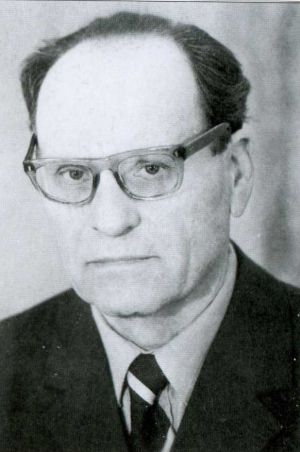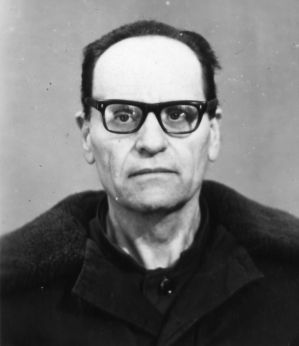Participant in the national liberation movement of the 1940s-90s.
His parents, Andriy Mykolaiovych and Yeva Dmytrivna (1902–1979), were peasants.
From the age of 14, Kuzma joined the underground struggle. In the autumn of 1940, together with his uncle Ivan Dasiv, an OUN member, he illegally crossed the border into Hungary and was imprisoned there for two weeks. The Hungarian police did not return him to the USSR but, at night, moved him to the territory of Poland, which was occupied by Germany. He wandered abroad in hunger and performing hard labor. He studied for a short time at the Ukrainian Technical and Economic Institute in Poděbrady (Czech Republic). With the outbreak of the German-Soviet war, he illegally returned home. He became a liaison for the OUN underground, then the stanychnyi (local leader) of the Hrabovets cell of the OUN youth organization “Yunatstvo.” On November 5, 1942, he was captured on a train by the railway police and sent for forced labor in Germany. With the fall of the “Third Reich,” he intended to go to the West, but his friends advised him to return to his native land.
The “liberators” held Dasiv in the Khyriv NKVD filtration camp for a month and a half, interrogating him at night, intimidating him, and threatening him with imprisonment for “betraying the motherland.” He returned home on June 12, 1945.
In his native Hrabovets, he again became involved in underground work. His mother—OUN stanychna “Bohdana”—was arrested in 1946. She was released in 1956.
Meanwhile, he worked as a lumberjack, a secretary of the village council, a state insurance inspector, and completed accounting courses. From 1953, he lived in Boryslav, and on July 3, 1955, he married Vira Fedorivna Mrykh. In 1959, their daughter Oksana was born.
As early as 1947, Dasiv possessed “The Decalogue of a Ukrainian Nationalist,” “The Prayer of a Ukrainian Nationalist,” “The Resolutions of the Second Great Assembly of the OUN,” and O. Terletsky’s work “The Liberation Struggle of the Ukrainian People.” In 1959, he rewrote them and gave them to friends to read. From that time on, he had printing type.
In 1957, Dasiv enrolled at the Lviv Polytechnic Institute, completed three years, but had to stop his studies due to his health. He worked as a senior engineer at the Boryslav Road Construction Department No. 7.
When the offensive against Ukrainian identity intensified after the “Khrushchev Thaw,” Dasiv and like-minded individuals decided to set up an underground printing and distribution of leaflets. An attempt with a hectograph failed. From 1964 to 1966, Roman Boiko, a worker at the Boryslav city printing house, at Dasiv’s request, gradually collected several kilograms of type, and in 1966, also ink and paper. Dasiv kept the type in a cemetery in the village of Popeliv.
In the summer of 1969, Dasiv composed a leaflet for the 10th anniversary of S. Bandera’s death, which he personally typeset, and printed about 130 copies. He mailed about 50 leaflets from Stryi on November 2, 1969, to the addresses of magazines, newspapers, and private individuals, including to eastern Ukraine, and an equal number from Lviv on April 24, 1970. Eighty-four copies reached the KGB from institutions and individuals.
From 1968 to 1969, Dasiv wrote by hand, in three copies, a fundamental article titled “50 Years of Soviet Power in Ukraine,” in which he analyzed the national and economic policies of the CPSU. For this, he used a foreign-published book, “The Assertion of Ukraine's Rights,” and other sources. He gave the manuscript to acquaintances to read. He re-photographed some articles from the book, namely those by V. Lypynsky, S. Petliura, M. Mikhnovsky, and documents of the Central Rada, and made prints from them.
When a new wave of arrests swept through Ukraine, Dasiv wrote a leaflet in the summer of 1973 in defense of the arrested, the Ukrainian language, and culture, and printed 200 copies. He only managed to send 25 copies from Lviv on November 20. He gave 150 leaflets and the printing equipment to his friend Mykola Kobyletsky for safekeeping.
On Sunday, November 25, 1973, on Lenin Avenue in Lviv, Dasiv was punched in the solar plexus, seized, and thrown into a car. Within minutes, they arrived at the KGB headquarters on Myr Street. During a search, they confiscated 15 addressed envelopes containing 17 copies of this leaflet.
The investigation was led by KGB Major Borys Malykhin, who lamented: “Eh, these aren’t the old times. Our hands are short now, or I’d have put you in the ‘Yezhov mittens’!” The head of the investigative department, Major Vasyl Klymenko, assessed Dasiv's abilities thus: “You've misdirected your talent. If you, a man with no special education, no help from scientists, no necessary literature, had written a different study, something like ‘The Struggle for the Establishment of Soviet Power in Ukraine,’ you would have outshone all those professors and doctors of sciences sitting in universities and institutes!”
From April 12–15, 1974, Dasiv was convicted in a closed session of the Lviv Regional Court, presided over by I. Khomiuk. He was charged with conducting anti-Soviet agitation and propaganda under Part 1 of Art. 62 of the Criminal Code of the UkrSSR by the Lviv oblast prosecutor A. Rudenko—the brother of the Prosecutor General of the USSR, R. Rudenko. The sentence was 7 years of imprisonment in a strict-regime camp and 3 years of exile.
He served his time in Mordovia (ZhKh-385/19, Lesnoy settlement) and Perm oblast (VS-389/37, Polovynka settlement). In his dealings with the administration and KGB officers, he was principled and uncompromising, but he had a weak heart, so he refrained from participating in protest actions.
On November 25, 1980, he arrived in exile in the village of Evensk, Magadan oblast. He worked as a mechanic in a geological exploration group until the end of his exile (July 21, 1983) and remained there until his retirement in 1985. He returned with his health broken.
On March 31, 1993, he was rehabilitated. He wrote four notebooks of memoirs, which have not yet been published. In them, among other things, there is a detailed chronicle of events in the camps and short essays about fellow prisoners of various nationalities.
Bibliography:
Herald of Repressions in Ukraine.— New York: Foreign Representation of the Ukrainian Helsinki Group. – 1981, Issue 2, p. 212.
Roman Pastukh. The Underground Printer from Boryslav // Naftovyk Boryslava, No. 34 (6557), 1995. – May 4.
Ivan Hnatiuk. Kuzma Dasiv (1925–1993). // Drohobychchyna – Land of Ivan Franko. – Drohobych: “Vidrodzhennia” Publishing Company, 1997. – pp. 691–692.
Encyclopedia of Modern Ukraine, Vol. 7. – K.: Institute of Encyclopedic Research of the National Academy of Sciences of Ukraine, 2007. – p. 235.
Resistance Movement in Ukraine: 1960–1990. Encyclopedic Directory / Foreword by Osyp Zinkevych, Oles Obertas. – K.: Smoloskyp, 2010. – pp. 193-194.
International Biographical Dictionary of Dissidents of the Countries of Central and Eastern Europe and the Former USSR. Vol. 1. Ukraine. Part 1. – Kharkiv: Kharkiv Human Rights Protection Group; “Prava liudyny.” – 2006. – pp. 1–516; Part 2. – pp. 517–1020; Part 3. – 2011. – pp. 1021-1380. Dasiv K.: pp. 1108-1110: https://museum.khpg.org/1120656493
Materials from the archive of K. Dasiv.
Vasyl Ovsiyenko, Kharkiv Human Rights Protection Group.
DasivK Characters 6,357.

DASIV KUZMA IVANOVYCH

DASIV KUZMA IVANOVYCH